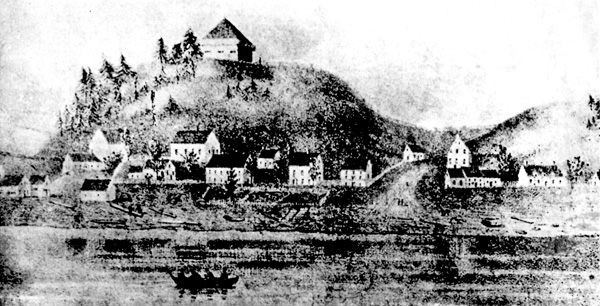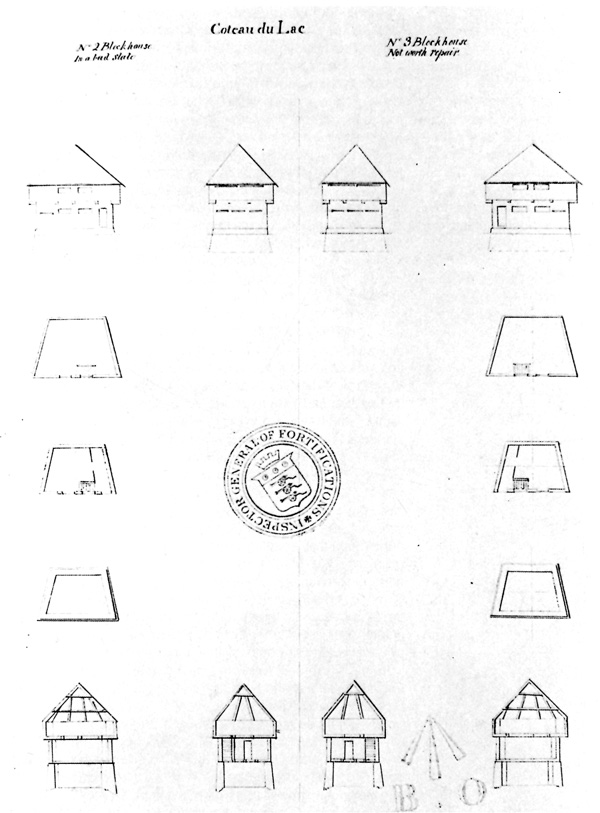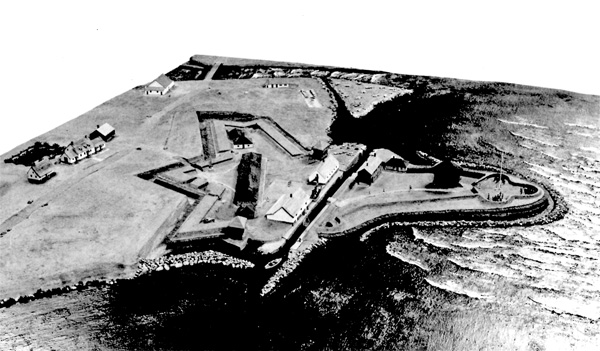|
|
 |
Canadian Historic Sites: Occasional Papers in Archaeology and History No. 23
Blockhouses in Canada, 1749-1841: A Comparative Report and Catalogue
by Richard J. Young
Part I: A Comparative Study
Blockhouse Barracks of Fort George, Fort Amherstburg and Fort St. Joseph
Most of the blockhouses in Canada were built, to a greater or lesser
extent, as barracks for troops. But the large blockhouses built in 1796
at Fort George and Amherstburg, and in 1797 at Fort St. Joseph, are
unique in one sense: the peculiar course of events determined that the
entire garrison and most of the stores were lodged in a single
blockhouse of a stockaded fort. These forts are excellent examples of
the temporary and expedient measures adopted by the British in times of
peace, which proved completely inadequate in wartime when cedar pickets
and musket-proof blockhouses were no match for the frontier war in the
making. These three forts spelled the end of the viability of stockaded
works on the Great Lakes system. Each of them was, appropriately,
destroyed in the War of 1812. Fort George was burned to the ground by
heated shot from American guns; Fort Amherstburg was burned by the
retreating British; Fort St. Joseph was abandoned by the British and
burned by the Americans.
By the provisions of Jay's Treaty (1794) which finally settled the
boundary dispute in North America, Great Britain promised to withdraw
her regular forces from the western posts within two years. The
withdrawal of these troops to British territory meant the establishment
of three new frontier posts: Fort George on the Niagara frontier; Fort
Amherstburg at the mouth of the Detroit River, and Fort St. Joseph on
St. Joseph Island in Lake Huron. Because the treaty had settled the
outstanding point of contention between Great Britain and the United
States, a long period of peace was expected. Consequently Parliament was
not inclined to spend a great deal of money to establish strong frontier
defences. The three posts which were built were designed principally to
be inexpensive, temporary, defensible storehouses and barracks.
Political and commercial considerations outweighed those of the
military. The forts had to be maintained and garrisoned to provide a
rendezvous for the Indians, and a mechanism for the distribution of
gifts and supplies to them which would, Britain hoped, assure the
necessary alliances against the eventuality of another war with the
United States. The posts were also maintained in order to protect and
control the fur trade.
While the entire establishments of Niagara, Detroit and
Michilimackinac were removed across their respective waterways, the
original large blockhouses built at the three posts were designed as
catch-alls for stores and troops. A good example is provided by the
blockhouse on St. Joseph Island. In 1806, the room use of this
blockhouse was as follows: the upper storey was divided into six rooms,
including two large ones for the soldiers and four smaller ones for
officers' quarters; the lower storey was divided into four rooms,
including an ordnance store room, a room for provisions and commissary
stores, one room for Indian Department stores and one for regimental
stores. All were in a very crowded condition.1
The three original large blockhouses were all built from a single
plan prepared by Gother Mann, the Commanding Royal Engineer in
Canada.2 They were large enough to contain immediately those
stores which had to be put under cover. The blockhouses measured 96 feet
by 26 feet in the lower storey and 100 feet by 30 feet in the upper. The
upper storey, because it was used as a barracks, was loopholed for
rifle fire. The sequence in the establishment of the forts was the same
in all three cases: large blockhouses were erected in 1796 to
accommodate the troops and necessary stores, followed closely by the
erection of magazines to keep powder dry and of picketing to prevent
stealing and to define the work. Finally, over a period of years, each
fort grew slowly and found its own level, determining which buildings
were necessary to allow the proper functioning of each department.
Fort George
Fort George3 was begun in 1796 on a point of land about a
mile from the mouth of the Niagara River, just in advance of the town of
Newark which was then the administrative capital of the upper province.
When completed the fort consisted of six bastions connected by
12-foot-high cedar picketing; the whole was surrounded by a ditch. Guns
were mounted in the six solid earth bastions. Inside the fort stood
three blockhouses, one large one flanked by two smaller ones, north and
south. The large blockhouse, called the "Centre Blockhouse," was the
original building in the fort. It measured 96 feet by 26 feet in the
lower storey. In 1803 the upper storey was divided into four small rooms
for officers' quarters and two large rooms for soldiers.4 The
lower storey was divided into one large room for ordnance stores and two
smaller rooms for regimental stores. The "North and South Blockhouses,"
as the two smaller ones were called, were built in 1797 to accommodate
the increased garrison. They were identical buildings, each measuring 41
feet by 21 feet in the lower storey. They were used as barracks and
could contain 100 men each.5 An octagonal blockhouse was
constructed in the southeast redan of the fort in 1800. This work was
constructed to help cover the powder magazine, which was inside the fort
near the southeast bastion. The fort also contained a storehouse,
officers' quarters, guardhouse and kitchen.6
The poor location of Fort George (it neither commanded the mouth of
the river nor protected the town) and the vulnerability of the wooden
defences were perfectly demonstrated in the War of 1812. Lieutenant
Colonel Bruyeres had warned Prevost a year before the war that the
frontier posts were badly placed and extremely vulnerable. He stated
that
There is not one situation that can be considered as a safe
depot. The works are faced and lined with wood, the bastions connected by
palisades. The buildings are of wood, liable at all times to accident by
fire, and within the power of an enemy to be burnt whenever he chooses
to undertake it.7
The Americans chose to undertake it on 25 May 1813. A heavy
bombardment by the American batteries silenced the guns of Fort George
and burned every wooden building in the fort by noon. The following day
the main assault began and, in the face of overwhelming odds, Brigadier
General Vincent gave orders for the British troops to retreat. Before
they left, the British spiked their guns and set fire to the
magazines.8
The position was recaptured by the British in December of 1813, and
the fort was partially rebuilt. They also captured the American Fort
Niagara. With Fort George partly rebuilt, Fort Niagara in their hands
and the beginnings made on a fort at Mississauga Point, the British
were assured of control of the mouth of the Niagara River for the
remainder of the war. After the peace treaty, Fort George was gradually
allowed to fall into ruin, and the main British efforts for defence were
transferred to the more strategic Mississauga Point.

21 Parrsboro blockhouse, 1839.
(Public Archives of Nova Scotia.)
|

22 Blockhouse opposite Fort Saint-Jean, 1778.
(Public Archives of Canada.)
|

23 Two blockhouses at Coteau-du-Lac canal,
built in 1779.
(Public Archives of Canada.)
|
Fort Amherstburg
The fort at Amherstburg9 (alternatively called Fort
Malden) was begun in 1796. The site, which was chosen as a replacement
for Detroit, was at the western entrance of the Detroit River into Lake
Erie. The fort was located opposite Ile Bois Blanc, thereby commanding
the eastern channel of the river which passed inside the island. This
channel was the main shipping route, and had to be used by all but the
smallest boats.
The fort was similar to Fort George but enclosed less space. Four
small bastions faced with timber were connected by a predominantly cedar
picketing. The square measured 80 yards on a face, and the whole fort
stood about 30 yards from the river. In the centre of the fort stood a
large blockhouse similar to the centre blockhouse at Fort George. The
upper storey was again divided into four small rooms for officers and
two large ones for troops. In 1803 the lower storey was divided into
five rooms, two used by the adjutant, two used as a mess and kitchen and
one large room used for ordnance stores.10
After the American assault on York in May 1813 and the destruction of
Fort George a few weeks later, the post at Amherstburg was all but cut
off from reinforcements and supplies. With the American fleet under
Commodore Perry completely in control of Lake Erie, it was only a matter
of time before the fort at Amherstburg would have to be abandoned. In
the face of a naval blockade by Perry and the threat of a land assault
by General William Henry Harrison, Major Henry Proctor, commanding at
Amherstburg, ordered a retreat on 26 September 1813. Before they left,
the soldiers destroyed the barracks, shipyards and remaining
fortifications.11 Proctor's retreating army was defeated at
Moraviantown mission on 5 October 1813.
Although the Americans rebuilt the fort during their occupation of
it, and the British continued their restoration after the peace was
signed, there is no further evidence that blockhouses were ever again
constructed in the fort.

24 Model of Coteau-du-Lac, canal and defences.
(National Film Board.)
|

25 First blockhouse of Fort Wellington, 1813.
(Public Archives of Canada.)
|

26 Merrickville blockhouse, August 1969.
(Photo by author.)
|
Fort St. Joseph
Fort St. Joseph12 replaced Michilimackinac in 1797 as the
most westerly of the British fortified posts. The fort was 1,500 miles
from Quebec by the St. Lawrence-Great Lakes route. The situation chosen
for the new fort was on a small promontory of St. Joseph Island at the
entrance to the St. Marys River. The fort was intended to be the general
rendezvous for the Indians and fur traders of the area.
A large blockhouse, similar to those at Fort George and Amherstburg,
was begun first. Lieutenant Lacy of the Royal Engineers, supplied with a
plan by Gother Mann, was sent in the spring of 1797 to superintend the
erection of the blockhouse. Captain Peter Drummond, in command at the
island, was instructed to begin preparing materials for the blockhouse
pending Lacy's arrival.13 The blockhouse was begun that
summer, but for lack of materials could not be completed the first
year.14 Lieutenant George Landman, R.E., was ordered to St.
Joseph the next spring to complete the blockhouse and to begin other
works on the site.15 Landman supervised the construction of
the fort until it was completed in 1800.
The post, when finished, resembled Amherstburg. It was a picketed
square 100 yards on a side with bastions in the corners. Guns were
mounted in the two bastions facing the river. The large blockhouse,
exactly like those at Fort George and Amherstburg, stood in the middle
of the square. Other structures in the fort included an arched stone
magazine, a kitchen, two storehouses, officers' and men's guardrooms.
The top floor of the blockhouse was divided into four small officers'
rooms and two large rooms for soldiers. The lower storey was divided
into four storerooms.16
Captain Bruyeres reported to Prescott in August 1811 that the fort
was "in bad disrepair and incapable of any defence."17
Captain Charles Roberts, who commanded at St. Joseph when war was
declared in 1812, was of the same opinion. Rather than risk defeat on
the island, Roberts determined to take offensive action; accordingly on
16 July 1812, he led his small detachment and a band of Indians in a
successful attack on Michilimackinac. Because of Michilimackinac's
superior strength and position, the British were able to maintain the
post throughout the war. The fort on St. Joseph Island remained
unoccupied, and was burnt to the ground by an American force raised
against Michilimackinac.
The fort at St. Joseph was never rebuilt.18 The British
began fortifying Drummond Island in Lake Huron after the war. When that
island was awarded to the Americans, the British retired to
Penetanguishene.
|

